2006年4月30日 東京
竹田賢一 + 荒井真一 (日本)
"Tourist #8 International"
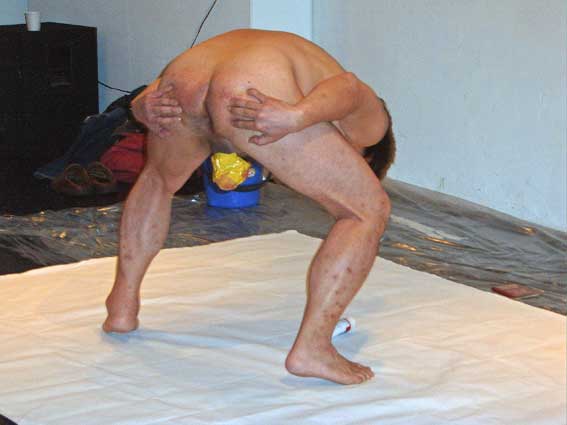
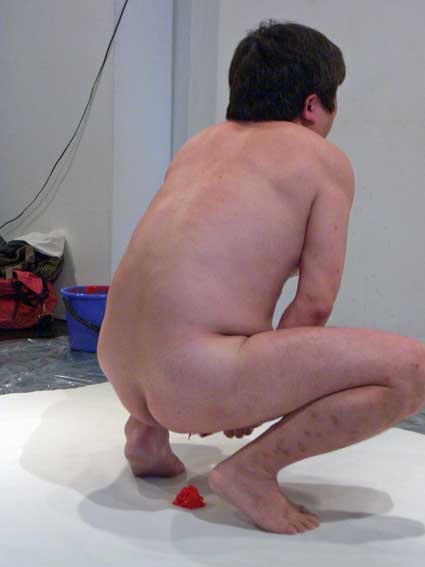
君が代を歌いながら
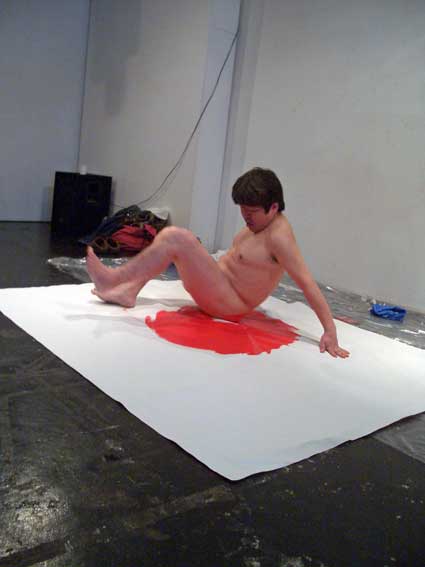
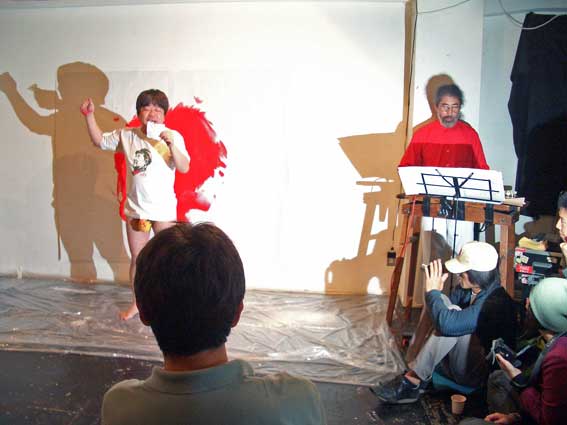
インターナショナルを歌う(右は竹田賢一)
"立て 飢えたるものよ
今ぞ 日は近し
醒(さめ)よ 我が同胞(はらから)
暁(あかつき)は来ぬ
暴虐の鎖 断つ日
旗は 血に燃えて
海を隔(へだ)てつ 我ら腕(かいな) 結びゆく
いざ 戦わん いざ
奮い立(ふるいた)て いざ
インターナショナル われらがもの"
歌詞:Eugene Pottier (Paris 1871年)
訳:佐々木孝丸・佐野碩 (1929年頃)
作曲: Pierre Degeyter (1888年)
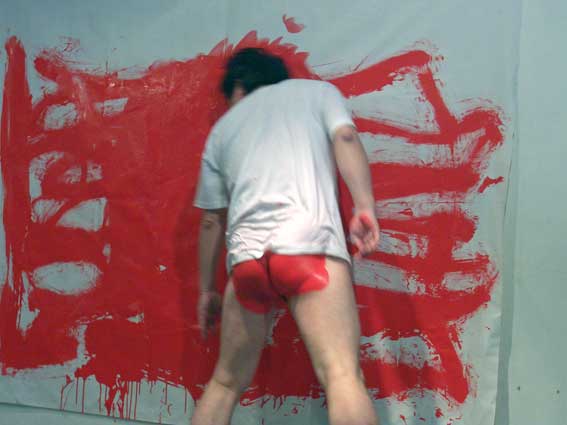
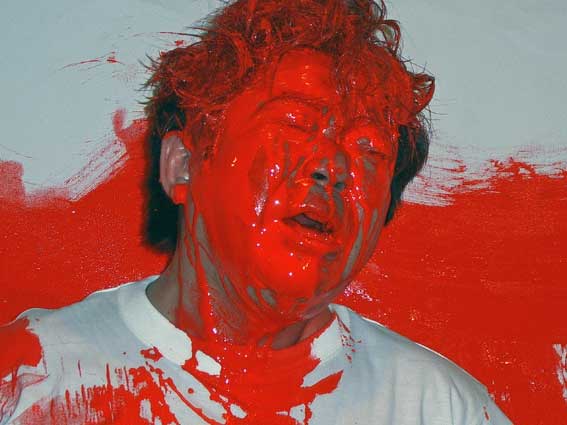
またインターナショナルを歌う
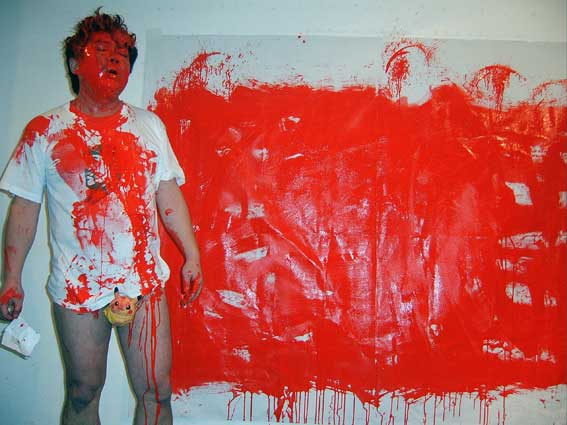
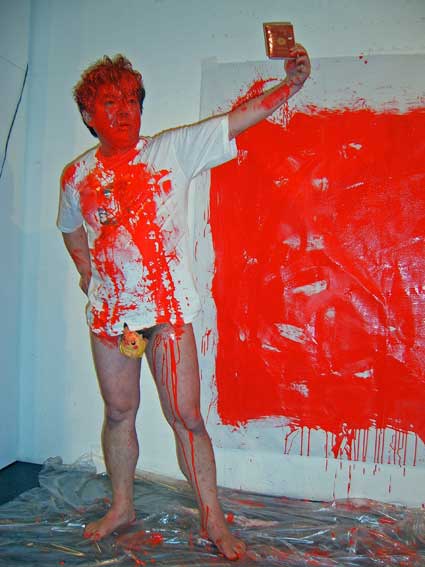
皇室の紋章に似た「菊」の紋を持つパスポートを掲げる
竹田賢一
http://am.jungle-jp.com/
竹田さんたちの「A-Musik」のページ。彼らの歴史的、今日的、すごい音楽が(ただ)で聴ける(ただより安いものはない、逆説的に。インターネットがあるから、こういう音源が私たちに届く。なければ、プレミアムが付いて、誰が儲かるのか)。
デザインがこっているので、とにかくクリックしまくってください(荒井真一)。
社会的緊張:荒井真一
創造性と卑しいナショナリズム
ベレニス・アングレミー(福住治夫訳)
("Art AsiaPacific"誌2004年春号, No.40)
荒井真一は,れっきとしたパフォーマンス・アーティストとして,1980年代から世界中,とりわけアジアや西ヨーロッパで活動している。彼のパフォーマンスは直接的で明快,あからさまだ。おそらく最初見たときには,あからさますぎると感じることだろう。
1950,60年代の大阪の「具体」運動や東京の「ネオ・ダダ・オーガナイザーズ」になじんだ,戦後の政治的志向をもつ前世代の日本のアーティストたちに強い影響をうけて,荒井のパフォーマンスは,ナショナリズムとアイデンティティ・オブセッションを指弾する。
最近,2003年の9月,中国の長春で開催された第4回オープン・アート・フェスティヴァルで,荒井はよく知られた「ハッピー・ジャパン!」を演じたが,これは1999年以来,5年以上にわたってつづけてきた彼の十八番のパフォーマンス作品だ。
このパフォーマンスで,まず荒井は,ダーク・グリーンのスーツ姿で登場する。彼の話すところによると,これは日本海外青年協力隊,すなわち,日本の文明を世界にひろめるための,40歳以下の若者の団体の制服だという。そしてこの組織の名誉会長は天皇陛下だ,と。
よく聞きとれる,淡々とした話しぶりで,彼は手にもった一冊の本を観客に紹介する。『戦争論』。問題になったミリオン・セラーのマンガ本である。
一見ふつうの,とりたてて問題になりそうもないこのマンガ本は,なかなかどうして,じつはウルトラ・ナショナリズム・プロパガンダのアンチョコ版のようなものだ。たとえば,第二次大戦中,日本の占領軍によって東南アジア女性に強いられた性的隷従とともに,南京大虐殺を否定するなど,近代日本史のさまざまな悲劇についての修正主義的論点をとりあげているのである。
つぎに彼は,着ているものを脱ぐ。身につけているのは,性器をおおうイチジクの葉っぱ代わりの,ピカチュー・ポケモンだけ。そして床にしゃがみこむ。日本の国歌を歌いながら,彼はお尻のすぐ下から,赤いペイントの入ったリキテックスのチューブを押ししぼる。まるでウンチをするように。
ウンチのうえの裸のお尻を使い,彼は白いキャンヴァスの真中に,円い,だが,いびつな朝日を描く。どうやら日章旗のつもりらしく,彼はあとで,それを壁にかかげる。
彼はそれから,くだんのマンガ本のページをあちこち任意に破りとり,いくつかを観客にあたえ,ほかは,セリフの数行を読んでから口のなかに押しこむ。「ハッピー・ジャパン」と叫びながらムシャムシャ。だが同時に,口のなかにいっぱいになった紙のせいで,彼の上ずったスピーチはとぎれとぎれ。すっかり呑みこまれてしまうまえに,声は荒れすさぶ。
ゆがんだ顔を涙が伝い,最後の,ほとんど言葉になっていない「ハッピー・ジャパン」が,むせぶ口から出てくるとき,このパフォーマンスは終わるのだ。
彼はアクティヴィストなのか?--------
日本のパフォーマンス・アート界の以外のところでは,しばしばそう思われているけれど。
彼はほんとうにアーティストなのか?--------
外国では,とりわけ中国では,彼はそのようにうけとめられているけれど。そう,中国での彼のパフォーマンスは,つねに観客の心を深く動かす。彼の作品が呼びおこす思いは,多層的・連続的なレヴェルにおよび,彼のパフォーマンスが見た目より陰影に富んだものであることがわかってくる。
このことはまた,彼のほかの作品についてもいえる。たとえば「ツーリスト・シリーズ」。その最後のエピソード「ツーリスト#7 ヴィヴァ グローバリズム!」も長安で演じられた。むきだしの政治的メッセージをもつこのパフォーマンスは,あまりにも陳腐で,かつおかしみに満ち,観客はついシニシズムにさそわれてしまいかねないほどだ。
ところが,とつぜん,これが痛切な混合のシーンによってかきみだされ,徐々に生みだされる強烈な感情の多層的な波が観客をのみこんでいく。ここにこそ荒井作品の真骨頂がある。彼の批評性は,子どものおもちゃのように見えながら,じつは大量生産と消費主義のおそるべき技術を顕現させるイメージの数々,すなわち,世界中の子どもたちの創造力を養うポケモンのフィギュア(イチジクの葉としてのピカチュー),また日本人の日常生活やアート・シーン(村上隆)でおなじみで,さらに西洋人好みの現代日本美術像をつくりあげるマンガの表象にもとづいている。
「豊かだといわれる日本,民主主義が成熟しているといわれる日本,表現の自由があるといわれる日本,この日本で私にできることといったら,泣き叫ぶことだけしかない」と,荒井は最近のインタヴューでいった。侵略戦争を経験した国は,自分たちの罪の意識を始末し,集合的責任を否定するために,いちどは修正主義的な局面をくぐる--------そのようにして,被害者の人間性,彼らの記憶と正義への権利を否定するという,さらなる罪を重ねるのだ。
出版社が,すくなくともポピュラーなマンガという形式によって本(『戦争論』)を商業的に成功させ,その修正主義的イデオロギーをひとつの社会現象に変えてしまうとき,居心地の悪さはかえって深まっていく。
荒井はみずからの政治的反逆をマイムや演技によって劇場的に表現するためにからだを使うのではない--------それを生きるのだ。彼はナショナリズムの根っこを食い,日本という国のシンボルを排泄することによって,自分のからだにみずからの政治的良心を経験させるのである。
しかも,日本の国旗のイメージをつくりだす彼のアクションは,国旗を焼いたり破ったりするありきたりの反体制的ジェスチュアからさらに一歩離れさせる。アクションは破壊とか間接的な用い方とかではなく,単純直截な創造にもとづいているのだ。
荒井は,彼がフェスティヴァルで「ハッピー・ジャパン!」とともにやりたがるほかのパフォーマンスでも,同じプロセスをたどる。すなわち,ナラティヴな語りに,アクション--------最初はコミカルで,ついで強烈な,あるいはドラマティックでさえあるアクション--------がつづくのである。
「ツーリスト#4 グローバリズム/インターナショナリズム」「ツーリスト#6 あんたはダメだ」「ツーリスト#7 ヴィヴァ グローバリズム」といった彼の中国における最近のパフォーマンスは,すべて過剰なコマーシャリズムを批判する。アクションにおけるそのからだは,社会的緊張にたいするひとつの焦点となって自己主張し,態度は形式となる。
彼のパフォーマンスは時に観客を当惑させることがある--------
彼が提起する問題ゆえなのか,それともたんに,彼自身のからだの,そこまでさらしてしまうのか,といわせるほどの生な存在ゆえに。
それでいてなお,彼のからだは見せものではなく(ショウ--------劇場的パフォーマンスなら,観客はもっととっつきやすいだろう),アートの道具でもなく,パフォーマンスの瞬間におけるアートなのだ。
このように荒井作品は,1950年代初頭からはじまるパフォーマンス・アートの最もラディカル表現-----日本の具体グループやネオ・ダダ・オーガナイザーズ,オーストリアのウィーン・アクショニスト,アメリカのボディ・アート-----とつながる。
アジアでは,パフォーマンス・アートはまず日本で,西欧と同じようなカウンター・カルチュアの理想の出現にみちびく気風のなかで発達した。1955年,吉原治朗によって大阪で創立された有名な具体グループと東京のネオ・ダダ・オーガナイザーズが基調------時には戦後,ヒロシマ後の荒廃にたいする政治的反応として発現する,ラディカルで身体的なアート-----となる。
社会的・政治的プロテストの文脈にある1980年代の霜田誠二のような,どの系譜からも離れたアーティストのアクションも,演劇と詩のタッチをともなって,パフォーマンス・アートに私的な次元とフォーマリズムの美学をあたえた。日本におけるこんにちのパフォーマンス・アート・シーンが,霜田誠二のエネルギーに多くを負っていることは,いうをまたない。彼は1993年,日本国際パフォーマンス・アート・フェスティヴァル(NIPAF)をはじめて以来,主として日本とアジアからのパフォーマーたちに刺激をあたえ,彼らを結集してきた。
あらゆる形式のパフォーマンス・アートに開かれたこの文脈のなかで,荒井のようなアーティストたちは,自由な意思による,魅力的で創造的な行為を存分に発揮することができたのだ。
荒井のアート言語は,彼自身の国の現代アート・シーンの基本的な部分となっていることは疑いない----ユーモアと洞察をもって経験される,主としてグローバリズムとナショナリズムの問題を標的とする彼の政治的対抗(そのあからさまさにもかかわらず,そして,それゆえにこそ,とあえていおう)は,彼の個人的な経験の表現と彼のパフォーマンスの美学的次元に先立つ。荒井は,NIPAFの多くのほかのパフォーマーにくらべてそれほど詩的でもフォーマリズム的でもないけれども,彼の作品の力によって,私たちに,ありふれたイデオロギーの暴力の再考を迫る。つまり,まさに私たちが,どこにイデオロギーの罠があるかすでに知っていると思っているがゆえに,無意識のうちにもその力を忘れてしまう。それゆえ私たちは,自分たち自身のシニシズムのスペクタクルに屈するというわけなのだ。
*ベレニス・アングレミーは北京を本拠とするフリーランスの美術批評家。北京のDIAF(Dashanz International ArtFestivalの実行委員長でもある。
Social Tensions: ARAI Shin-ichi
CREATIVITY AND ABJECT NATIONALISM
by Berenice Angremy
("Art AsiaPacific" Spring 2004, No.40)
ARAI Shin-ichi is an established Japanese performance artist who has been working around the world since the 1980s, especially in Asia and Western Europe. His performances are direct, clear and obvious -- perhaps too obvious at first glance.
Strongly influenced by an earlier generation of politically minded postwar Japanese artists associated with the Gutai movement in Osaka and Neo-DADA-organizers in Tokyo in the 1950s and 60s, Arai's actions and performances denounce nationalism and identity obsession.
Recently, at the 4th Open Art Festival which took place in Changchun, China, September 2003, Arai performed "Happy Japan!," a well known performance work which is his signature piece having been performed more than ten times since 1999.
For the performance, Arai dressed soberly in a dark green suit which, he tells us, is the uniform of Japan Overseas Cooperate Volunteers,
a body of young people under 40 to propagate Japanese civilization around the world. And the honorary president of the Organization is
the Emperor.
In a clear, unemotional speech, he introduces his audience to the book he holds in his hands, "War theory," a controversial comic book that has sold a most a million copies.
It looks like an ordinary, inoffensive comic book but is in fact a compendium of ultranationalist propaganda, featuring revisionist theses about tragedies of modern Japanese history-denying, for instance, the Nanjing genocide in China as well as the sexual slavery imposed on Southeast Asian women by the occupying Japanese army during the Second World War.
He then takes off his clothes, keeping only a small yellow "Pikachu Pokemon" fig leaf on his genitals, and squats on a square white canvas on the floor. While singing the Japanese national anthem, he presses a plastic tube of Riquitex containing red paint from just below his buttocks, as if excreting red human waste.
Using his bare buttocks on the "waste," he paints a full but irregular rising sun in the middle of the white canvas that turns out to be a copy of the Japanese national flag, which he later hangs on the wall.
He then tears out random pages of the comic book, giving some to the audience, and stuffing others into his mouth after reading out a few lines. He chews them, shouting "Happy Japan." At the same time, the accumulation of paper in his mouth blocks his emotional speech, making his voice hoarse before it disappears entirely inside his throat.
The performance ends when a last, almost inaudible "Happy Japan" emerges from his suffocating mouth, while tears run down his pain-distorted face.
Is Arai an activist -- which is how he is often perceived in Japan outside performance art circles? Is he really an artist -- which is how he is received abroad, especially in China where his performances always move his audiences deeply? The emotion prompted by his work is on multiple and successive levels, and reveals that his performance is subtler than it seems:
it goes beyond the simple eruption of anger and rage provoked by ultra nationalism, slowly assuming innocuous form.
This is also the case of his other performance pieces -- such as the Tourist's Series, the last episode of which, "Tourist #7 Viva Globalism!," was also performed in Changchun:
a performance with a crude political message, so banal and comic that it may lull the audience into cynicism, is suddenly disturbed by scenes of painful incorporation, the multiple waves of intense emotions produced progressively engulfed its audience; herein lives the force of Arai's work. His criticism is based on images which despite looking like childish artifacts, reveal terrifying techniques of mass production and consumerism:
the Pokemon figures (Pikachu as a fig leaf) which feed the imagination of children the world over; and the Manga images which are present everyday in the life of Japanese people and in the art scene (MURAKAMI Takashi) and beyond, forge the image that Westerners have of contemporary Japanese art.
"Here in Japan, which is said to be rich, to be a mature democracy, to have freedom of expression, all I can do is just cry," Arai said in a recent interview. All societies which have experienced wars of aggression go through revisionist phases to deal with their feelings of guilt and to deny their collective responsibility -- and thus commit another crime, that of denying the humane essence of their victims and their right to memory and justice.
When a publishing house transforms its revisionist ideology into a social phenomenon, with the commercial success of a book (War theory) at least in part due to its popular Manga form, the sense of unease goes even deeper.
Arai doesn't use his body to express his political rebellion in a theatrical fashion, by miming or acting it out -- he lives it. He makes his body experience his political conscience by eating the
source of nationalism and defecating the symbols of the Japanese nation.
Moreover, his body in action creating the image of the Japanese flag
takes him even further from the traditional anti-establishment gesture:
the burning or shredding of the national flag. Action is not based on destruction, or indirect use but on simple, straightforward creation.
In other performances, he insists on performing
along with "Happy Japan!" at festivals, Arai follows the same process:
a narrative discourse, followed by action -- first, comical, then intense or even dramatic.
All his recent performances in China -- "Tourist #4 Globalism/lnternationalism", "Tourist #6 You're no good" and "Tourist #7 Viva Globalism" denounce excess consumerism. The body in action becomes a focus for social tensions to manifest themselves and attitude becomes form.
His performances can sometimes disturb his audience -- either because of the issues he raises or simply because of the taboo, intimate presence of his own body, naked or clothed.
Yet, the body of Arai is not on show (a show -- a theatrical performance -- is easier for an audience to assimilate), it isn't a tool in the service of art -- it is art at the moment of performance.
In this way, the work of Arai links up with the most radical expressions of performance art from its beginnings in the 1950s -- the Gutai Group and Neo-DADA-organizers in Japan, the Viennese Actionists in Austria, and Body Art in the U.S.
In Asia, performance art first developed in Japan, in an atmosphere conducive to the emergence of counter-culture ideals similar to the ones present in Europe and America. The famous Gutai group founded in 1955 in Osaka by YOSHIHARA Jiro, and the Neo-DADA-Organizers in Tokyo, set the tone:
a radical, physical art of expression which would occasionally manifest itself as a political response to the desolation of post-war, post-Hiroshima Japan.
The isolated actions of artists such as SHIMODA Seiji in the 1980s, while set in a context of social and political protest, were also accompanied by touches of theatre and poetry which gave performance art a personal dimension and a formalist aesthetic. The contemporary performance art scene in Japan undoubtedly owes much to the irrepressible energy of Shimoda, who ever since the creation of the Nippon International Performance Art Festival (NIPAF) in 1993, has inspired and gathered together performers mainly from Japan and Asia.
In this context open to all forms of performance art, artists like Arai have been able to give free rein to their libertarian, challenging and creative acts.
Arai's artistic language is undoubtedly a fundamental part of his own country's contemporary art scene -- in that his political opposition, mainly aimed at issues of globalism and nationalism, experienced with humour and insight (despite and we should say because of its obviousness) precedes the expression of his personal experiences and the aesthetic dimension of his performances. Although less poetic and formalist than many other performers in NIPAF.
Arai forces us by virtue of his work to rethink the violence of quotidian ideology:
precisely because we all think we already know where the trap of ideology lies and hence unconsciously dismiss its force. We therefore succumb to the spectacle of our own cynicism.
Berenice Angremy is a freelance art critic based in Beijing, China. She is also Executive
Director of DIAF, Dashanzi International Art
Festival in Beijing.
=>Back to Great East Asia Co-prosperity Restaurant
=>Great East Asia Co-prosperity Restaurant web in English
=>Back to ARAIart web
ARAI Shin-ichi (web master/shinichiarai@hotmail.com)







